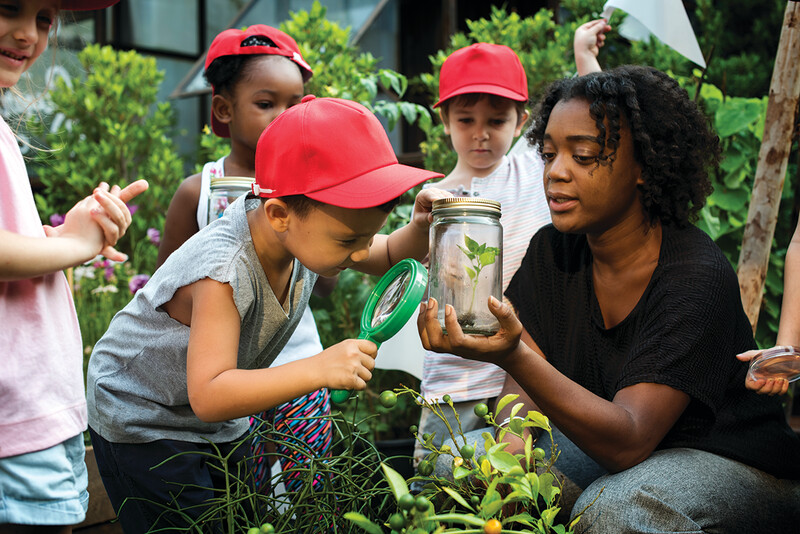While most schools and districts nationwide scrambled to teach students online, a small group of innovative educators blazed a different trail for learning during coronavirus—one that led to the great outdoors. Across Colorado, for example, students returned to open-air classrooms complete with shade structures, outdoor rugs, internet hotspots, projectors and screens, and stadium seats (Schimke, 2020).
While outdoor learning may seem like out-of-the-box thinking, it's hardly new. A century ago, as tuberculosis ravaged U.S. cities, schools built open-air classrooms, wrapped children in blankets, opened windows in cafeterias—and by all counts, kept kids safe (Bellafante, 2020). As it turns out, for more than a decade, outdoor preschools have been quietly popping up worldwide in an effort to apply the findings that decades of child studies (e.g., Vygotsky, 1978) have shown about the importance of play in helping children learn vital self-regulation and social skills. Seems that research (e.g., Louv, 2005) finds children are happier, healthier, and more attentive when outdoors.
The Great Outdoors
Most outdoor preschools are small and loosely structured. Their curricula typically mix some traditional learning (mathematics and literacy) with open-ended exploration and curiosity. A teacher might start the morning with a math lesson, using pinecones as manipulatives, or read a book to children about caterpillars and butterflies. Much of the day, though, remains loosely structured, with students exploring the outdoors and engaged in free play.
Outdoor preschools do have their detractors. In addition to safety concerns, some note that because outdoor schools are often unlicensed, they tend to cater to children whose parents can afford unsubsidized childcare. Nonetheless, while these experiments are too new to have undergone rigorous study, some smaller studies suggest promising benefits to outdoor learning for all students.
Greater engagement and imaginative thinking. Studies of 6-year-olds in "forest schools" in the United Kingdom found that students were highly engaged in school and spent lots of time in imaginative play, which research shows fosters self-regulation and abstract-thinking skills (Coates & Pimlott-Wilson, 2019).
Improved attention and behavior. A study of a school in Tasmania that sent youth on outdoor "excursions" for 15 hours each week observed that many children previously labeled restless and hyperactive were more tranquil and focused outdoors (Haas & Ashman, 2014). A Florida study of two kindergarten teachers alternating between providing language arts lessons indoors and outdoors found that students were consistently more on-task when outdoors (Largo-Wight, Hall, & Guardino, 2018).
Critical thinking, social skills, and empathy. In Chili, a school that adopted an outdoor environmental studies program with a centerpiece 300 square-meter community garden found that children developed better critical thinking skills when they tended to the garden and cultivated plants (Ampuero et al., 2015). School administrators also observed that as students took care of the garden, they also took better care of each other. Fights and bullying decreased, and students were better able to see others' perspectives.
Well-being and academic outcomes. A U.K. study comparing the outcomes of 11 disadvantaged children (ages 5–7) in a "forest school" with matched peers in traditional schools found those learning outdoors demonstrated significantly higher levels of emotional well-being (feeling at ease and free from social tensions) (McCree, Cutting, & Sherwin, 2018). Children in the forest school also demonstrated greater gains in reading, math, and writing abilities than their matched-comparison peers.
While these studies are far from empirical, they do seem to suggest that outdoor learning holds promise and could be a viable option for learning during the pandemic. So, how might schools incorporate these ideas into their own routines?
Start with More Sunshine
Positive effects often emerge from small steps toward outdoor learning, which could offer a creative way to deliver learning during a pandemic. We suggest these interim steps and guiding principles:
Increase outdoor time. Think of ways your classes might easily spend more time outdoors. The Tasmanian school, for example, started with just 15 hours of outdoor time per week and simple walks to a nearby nature preserve.
Create outdoor learning spaces. Your school does not have to be situated next to a wildlife preserve to hold outdoor learning. The school in Chile created its own "nature," converting a portion of the schoolyard into a garden; similarly, the school in Florida installed relatively inexpensive awnings to create an outdoor classroom next to the building.
Let kids explore. Some of the best learning occurs organically via unstructured exploration. In fact, a study of an outdoor kindergarten in Toronto (Ghafouri, 2014) offers a cautionary tale of a tour of a local farm that teachers noticed failed to ignite children's curiosity about farms or farm animals. Why? Because it was too structured; adults did too much talking, and kids too little exploring.
In many ways, outdoor schools are simply doing what we've long known is good for kids: getting them outside and letting them follow their curiosity. In doing so, these schools could point others to think outside of the (digital) box and bring a bit more ingenuity, creativity and boldness to creating learning experiences for students during a pandemic—and beyond.









